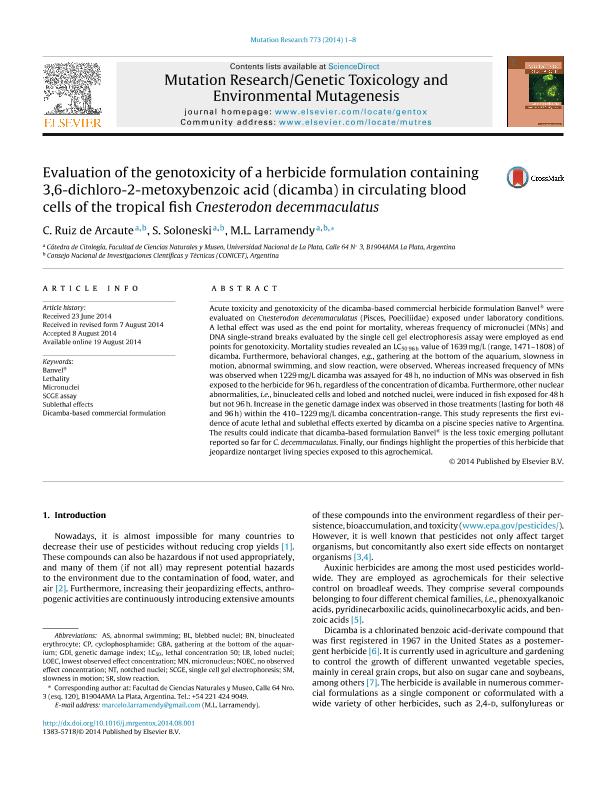Artículo
Evaluation of the genotoxicity of a herbicide formulation containing 3,6-dichloro-2-metoxybenzoic acid (dicamba) in circulating blood cells of the tropical fish Cnesterodon decemmaculatus
Fecha de publicación:
08/2014
Editorial:
Elsevier Science
Revista:
Mutation Research. Genetic Toxicology And Environmental Mutagenesis
ISSN:
1383-5718
Idioma:
Inglés
Tipo de recurso:
Artículo publicado
Clasificación temática:
Resumen
Acute toxicity and genotoxicity of the dicamba-based commercial herbicide formulation Banvel® were evaluated on Cnesterodon decemmaculatus (Pisces, Poeciliidae) exposed under laboratory conditions. A lethal effect was used as the end point for mortality, whereas frequency of micronuclei (MNs) and DNA single-strand breaks evaluated by the single cell gel electrophoresis assay were employed as end points for genotoxicity. Mortality studies revealed an LC50 96 h value of 1639 mg/L (range, 1471–1808) of dicamba. Furthermore, behavioral changes, e.g., gathering at the bottom of the aquarium, slowness in motion, abnormal swimming, and slow reaction, were observed. Whereas increased frequency of MNs was observed when 1229 mg/L dicamba was assayed for 48 h, no induction of MNs was observed in fish exposed to the herbicide for 96 h, regardless of the concentration of dicamba. Furthermore, other nuclear abnormalities, i.e., binucleated cells and lobed and notched nuclei, were induced in fish exposed for 48 h but not 96 h. Increase in the genetic damage index was observed in those treatments (lasting for both 48 and 96 h) within the 410–1229 mg/L dicamba concentration-range. This study represents the first evidence of acute lethal and sublethal effects exerted by dicamba on a piscine species native to Argentina. The results could indicate that dicamba-based formulation Banvel® is the less toxic emerging pollutant reported so far for C. decemmaculatus. Finally, our findings highlight the properties of this herbicide that jeopardize nontarget living species exposed to this agrochemical.
Archivos asociados
Licencia
Identificadores
Colecciones
Articulos(CCT - LA PLATA)
Articulos de CTRO.CIENTIFICO TECNOL.CONICET - LA PLATA
Articulos de CTRO.CIENTIFICO TECNOL.CONICET - LA PLATA
Citación
Larramendy, Marcelo Luis; Ruiz de Arcaute, Celeste; Soloneski, Sonia Maria Elsa; Evaluation of the genotoxicity of a herbicide formulation containing 3,6-dichloro-2-metoxybenzoic acid (dicamba) in circulating blood cells of the tropical fish Cnesterodon decemmaculatus; Elsevier Science; Mutation Research. Genetic Toxicology And Environmental Mutagenesis; 773; 8-2014; 1-8
Compartir
Altmétricas




